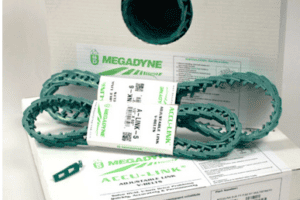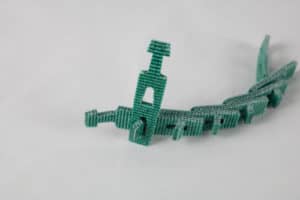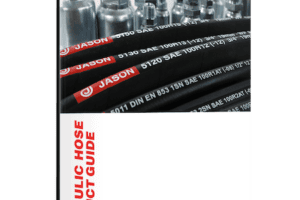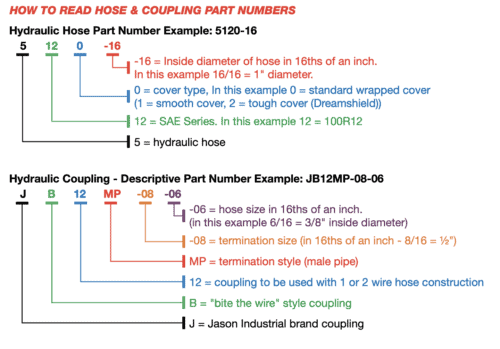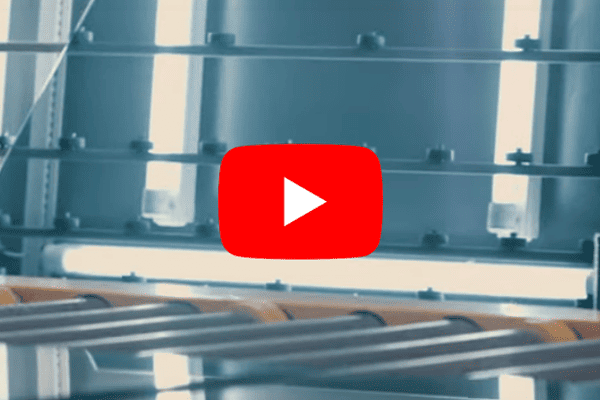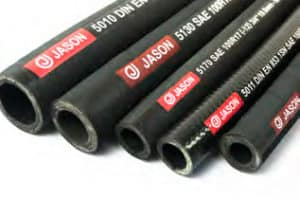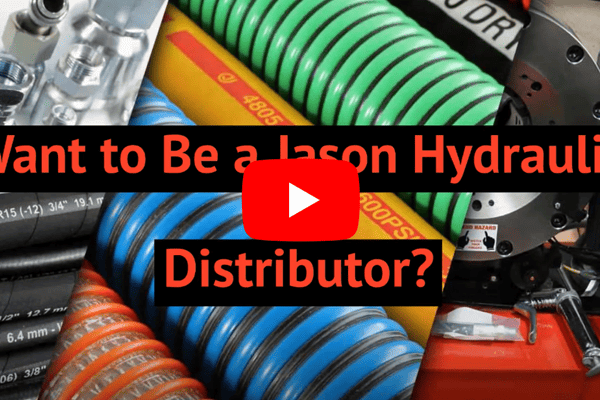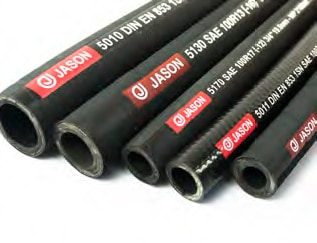Applications & Advantages of Accu-Link Adjustable V-Belts
Leave a CommentAccu-Link® is an adjustable link-style V-belt designed and manufactured by Megadyne as a versatile and durable alternative to standard rubber V-belts. Accu-Link consists of a chain of polyurethane links that are reinforced by high-quality multilayer woven polyester. Accu-Link was initially developed to serve as a fast, easy-to-install replacement for traditional V-belts in the event of a break, but new materials and manufacturing process improvements now make today’s Accu-Link a viable alternative for all comparable standard v belt applications.
Key Features and Advantages
The main attributes that make Accu-Link a Comparable performance product with superior benefits include:
- Easy assembly. The design allows for a simple and fast assembly by hand in seconds without the use of tools.
- Easy installation.Accu-Link has an adaptable design and can be easily installed on V-belt drives that are hard to access or difficult to take apart. Accu-Link can be installed open and joined on the drive. Alternatively, Accu-Link can be made endless and rolled onto the drive.
- Reduced inventory size. Any length of classical V-belt can be attained with just one roll of Accu-Link. Not having to stock individual belt sizes in various lengths results in inventories that are smaller, less costly, and easier to manage.
- High power rate. Accu-Link power ratings are comparable to that of traditional V-belts.
- Resistance to harsh conditions.The Accu-Link belt is composed of Polyurethane, which is capable of withstanding exposure to chemicals, salts, oils, and grease, facilitating an extended lifespan relative to traditional rubber counterparts.
- Broad temperature tolerances. Accu-Link functions in temperatures ranging from -25° C to 80° C (-13° F to 176° F).
- Tolerance of harsh environments. When exposed to tough or abrasive environments, Accu-Link wears better and lasts longer than traditional rubber V-belts.
- Quiet and smooth operation. The innovative manufacturing process used to make the links allows for smooth and precise side profiles, which translates to a quieter and smoother belt with fewer vibrations than traditional rubber V-belts.
Additional features and advantages of the Accu-Link belt include:
- Durable urethane impregnation
- Rugged polyester fabric
- Adjustable link construction and easy length modifications
- Versatile, adaptable, and interchangeable design
- Horsepower capacity equivalent to conventional V-belts
- Perfect for reducing belt vibration
- Clean running; no cracking; no black dusting
- Heat-dissipating construction
- Can be used s in conveying applications
- Functional on drives with turns
- Perfect for emergencies and service environment where always have the right belt size is necessary
- Can be rolled drive sheaves (no cord to damage)
- Can be used in single V-belt or multiple V-belts applications
- Runs cooler than conventional V-belts
Industries and Applications
Given its unique and adaptable link-style Accu-Link belt can be used for virtually any drive application. Manufacturing and service industries today rely on Link belts for use on problematic drives and in harsh operating conditions. Accu-Link is also fast and easy to install, making it the superior design choice for preventative maintenance and emergency repairs.
Some of the most common applications of the Accu-Link V-belt include:
- Marine industry. Accu-Link is composed of durable and long-lasting materials capable of withstanding salt, grease, and other harsh elements associated with marine environments.
- Poultry industry. The Accu-Link belt can endure the dirty and potentially harsh operating conditions associated with poultry farming.
- Agriculture industry. Engineered to withstand challenging environments, the Accu-Link belt is ideal for many agriculture-related applications.
- Glass industry. In glass manufacturing, the non-marking Accu-Link belt is preferable over standard V-belts, which frequently leave stains or marks on products.
- Air handling. Quick and easy installation makes Accu-Link a convenient option for use in air handler units. It is also clean running and a perfect choice for air handling in sensitive environmental application
- Metal and woodworking machines. Accu-Link is designed to enable a reduction in vibration and noise, making it ideal for metal and woodworking applications.
- Rolling conveyor. Accu-Link belts are superior to standard V-belts in their ability to tolerate pulley misalignment.
- Tile and marble conveyors. The conveyor process for tile and marble manufacturing can be harsh and abrasive on belts, causing undue wear early in their service life. Accu-Link belts are built to tolerate such conditions and can endure longer than standard V-belts.
Accu-Link Adjustable V-Belts From Megadyne
Accu-link is strong, long-lasting, and built to endure a wide range of V belt drive application. Whether you are looking for an easily installed product for fast emergency repairs or a strong and dependable product for everyday drive applications, Accu-Link will keep your operations running smoothly and efficiently. To learn more about Megadyne’s Accu-Link adjustable V-belts, please contact us or download our detailed brochure.
2020 Hydraulic Hose Product Guide Updates
Leave a CommentJason Industrial released a Hydraulic Hose line in 2018 after decades of being a leading source of industrial hose. Since our initial launch, we listened to customer feedback and expanded our product line to better serve market needs. Our updated Hydraulic Hose Product Guide contains the additions made to our product line along with answers to commonly asked customer questions. The product guide is available for download here.
Key Updates Include
- Hose with the Dreamshield™ cover, a special rubber cover compound that is 6 to 8 times more abrasion resistant than the current standard cover:
– Series 5012 – SAE 100R1AT, 1SN DIN EN853 – Wrapped MSHA Cover 1-Wire Braid Hose, Dreamshield™ Extra Abrasion Resistant Cover – Series 5022 – SAE 100R2AT, 2SN DIN EN 853 – Wrapped MSHA Cover 2-Wire Braid Hose, Dreamshield™ Extra Abrasion Resistant Cover – Series 5122 – SAE100R12, DIN EN 856 R12 – MSHA Cover 4-Spiral Hose – Dreamshield™ Extra Abrasion Resistant Cover – Series 5132 – SAE 100R13, DIN EN 856 R13 – MSHA Cover – 4 or 6-Spiral Hose 5,000 PSI Constant Pressure, Dreamshield™ Extra Abrasion Resistant Cover – Series 5152 – SAE 100R15, DIN EN 856 R15 – MSHA Cover – 4 or 6-Spiral Hose 6,000 PSI Constant Pressure, Dreamshield™ Extra Abrasion Resistant Cover – Series 5162 – SAE 100R16, – MSHA Cover – 2-Wire Braid Hose 47 Dreamshield™ Extra Abrasion Resistant Cover – Series 5172 – SAE 100R17 – 3,000 PSI Constant Pressure, 1 or 2-Wire Braid Hose Dreamshield™ Extra Abrasion Resistant MSHA Cover – Series 5192 – SAE 100R19 – 4,000 PSI Constant Pressure – MSHA Wrapped Cover Dreamshield™ Extra Abrasion Resistant Cover – 2-Wire Braid Hose - JIC340 – General Production Hose Crimper with InfoCrimp™ Controller
- Polyethylene Armor Guard used to protect hose assemblies from external mechanical damage
| Discontinued Part Number | Replacement Part Number |
| 1252 | 1248 |
| 1254 | 1249 |
| 1256 | 1250 |
| 4052 | 4048 |
| 4054 | 4049 |
| 4056 | 4050 |
| 4075-4516 | 4075-4216 |
| 1270-1604 | 1270-1404 |
3. Coupling 1271-3612 was discontinued
4. MyCrimp App instructions – Download our app to ensure you always have the latest safety information for using the correct hose, coupling and crimp specifications.
Download for iOS – https://apps.apple.com/us/app/mycrimp-jason-industrial/id1250484050
Download for Android – https://play.google.com/store/apps/details?id=com.customcrimp.jasonindustrial&hl=en_US
5.Easier to read “How to Read Hose & Coupling Part Numbers” graphic –
6.Updated “SAE Hose Working Pressures” chart
7.Updated Chemical Resistance Chart
8.Color coded pages
- Gray – General information
- Green – 1 and 2-wire braided hose and matching 12/JB12 couplings
- Purple – 100R12 Series hose and matching 40/JB40 couplings
- Yellow – 4 and 6-spiral hose and matching 60/JB60 couplings
- Blue – Oil Return and Transportation (Air Brake) hose and field attachable (reusable) couplings
- Red – Crimping equipment and accessories
9.Pictures and drawings included for all couplings
For any questions about our updated Hydraulic Hose Product Guide, please contact us
New AMMEGA Video
Leave a CommentWhether you need to transmit power or move a product we will keep your business moving.
Discover the inspiring world of Ammega:
Mixing & Matching Hydraulic Hose and Couplings
Leave a CommentAs we progress through our introduction of hydraulic hose and coupling products at Jason Industrial, there have been a number of requests for interchange to competitors’ hose and couplings.
The term “interchange” needs to be clarified. No hydraulic hose or coupling is truly interchangeable because each manufacturer produces products that are tailored to their own processes and equipment. This is why mixing and matching is never recommended by anyone concerned about the satisfaction and safety of their customers and end users. Even though a particular hydraulic hose may carry the same SAE, ISO, or EN standard labeling, they are not made to the same tolerances and materials.
The same is true for couplings, perhaps even more so. Nearly every manufacturer has developed their own unique designs customized for their own validated and approved hose products. Additionally, the assembly specifications for crimping these hoses and couplings are unique to each piece of equipment.
Let’s focus on the coupling side of interchange for today’s discussion. Jason currently has three series of couplings for our hydraulic hose products.
- The JB12 for our 1 or 2 steel braid reinforced hoses
- The JB40 for our 100R12
- The JB60 for our 100R13
Other manufacturers may have one series that covers both wire braid and some wire spiral such as 100R12 or even 100R13 (skived). Others may have a series that covers thermoplastic hoses like 100R7 and can be crimped on certain wire braid hoses like 100R16, but not 100R2. While there are many similar examples, the bottom line is always the same: it is never going to be a one to one direct interchange.
So how do you address this when you’re working with a customer who could move to Jason as a supplier? We recommend that you first sort out which hoses the customer is using or wishes to buy. Once you’ve established this list, evaluate the competitor’s couplings to identify an equivalent Jason part to provide the connector ends needed for the hoses we’re offering. This will ensure that the customer will have the correct hose and couplings for their needs when an order is processed.
Think of “interchange” as more of a cross reference for the correct hose and necessary connections. Yes, it can get a little complex, but your Jason team can support you to guarantee the correct products. Don’t be afraid to ask if you need help or have any questions.
California Proposition 65: Compliance and the Jason Industrial Portfolio of Products
Leave a CommentEffective August 30, 2018, Proposition 65, also known as the Safe Drinking Water and Toxic Enforcement Act of 1986, will be expanded to include almost 1,000 chemicals known to cause cancer or reproductive toxicity. As a result, the previous generic warning enacted in 1986 will need to be replaced with a warning that identifies specific chemical ingredients used in the manufacture of products shipped to California.
Full implementation of the Prop 65 amendment means that violators will face sanctions for failing to comply with the requirements set forth. Jason Industrial is making sure that we will be fully compliant with Prop 65 before the deadline. To further explain this law and its purpose, we will explore the history of Prop 65, why there is a demand for more specific warning labels on product packaging, and the steps we are taking to achieve full compliance with the law.
History of Proposition 65
When it was enacted and approved by a majority of California voters in 1986, Proposition 65 – or the Safe Drinking Water and Toxic Enforcement Act of 1986 – sought to keep harmful and carcinogenic chemicals out of California’s drinking water, and to warn residents if water they used for drinking and cooking had been potentially contaminated. The list of harmful chemicals has grown significantly since that time—there are now more than 1,000 chemicals on the list.
Previously, only generic warning labels on products containing these chemicals had been required. In 2016, the law was amended to require all businesses to add more specific warning labels on the full range of products now covered by the law.
Jason Industrial’s Compliance
Jason Industrial is currently taking all required steps to be fully compliant with Prop 65 before the deadline. As a first step, we have identified all products that need packaging with the required new labels under the amended Prop 65.
These products are shipped from our branches, whether to California or from other U.S. customer locations that may ship to California will have the proper warning label attached. Additionally, we will label the outside of shipping boxes noting Megadyne Americas compliance with Proposition 65 beginning August 30th, 2018. Customers receiving products that include chemicals noted on the revised proposition must ensure they carry the warning labels to their customers.
To ensure that we do not miss anything, we will send instructions and labels to all Jason Industrial shipping points so that products which may contain these chemicals can be pinpointed.
Learn More
Jason Industrial by Megadyne is dedicated to the health and safety of our customers. Additional information can be found on California’s Proposition 65 website. To download the full Proposition 65 chemical list, visit the California Office of Environmental Health Hazard Assessment’s website. If you have questions or concerns, please contact us to learn more about our compliance with Proposition 65.
Introduction to Our North American Hydraulic Line
Leave a CommentWatch Roy Pyle, Jason Industrial’s VP of Fluid Power, discuss our line Hydraulic Hose and Couplings for the North American market with Fluid Power World’s Lisa Eitel. Additional information about our complete Hydraulic line can be found in our Hydraulic Hose Product Guide or by contacting us.
How & When to Replace a Hydraulic Hose
Leave a CommentIn hydraulic systems, hoses carry pressurized hydraulic fluid to or from pumps, motors, valves, actuators and other system components. Due to their critical function, the hoses employed are designed and constructed for suitable flexibility and durability. They must be flexible enough to bend in and around the confines of equipment, fit into tight spaces and may span long distances while being durable enough to withstand the high operating pressures and temperatures. For these reasons, they are generally made from a combination of multiple layers of materials—such as elastomers, fluoropolymers, thermoplastics, textiles and metals. Typically, hydraulic hoses have an inner lining or tube made of rubber or thermoplastic, braided or spirally applied reinforcement layers of textile yarn or wire and a cover also made of rubber, thermoplastic or braided material. All of these are uniformly bonded together as one unit. Finally, for a hydraulic hose to be useful it requires suitable connections with hose fittings (permanent or reusable type) designed to attach to the hose to allow full utilization of the hose’s rated pressure and performance for maximum service life. It is vital to achieving this maximum acceptable service life and safe use that only manufacturers matched and approved components must used together and assembled to their recommendations. Mixing/matching of hose components outside of this recommendation can lead to unsatisfactory performance and disaster.
While hydraulic hoses are highly durable, the pressure cycles they experience through normal operation and natural degradation will eventually lead to failure. If hose failure occurs unexpectedly, it can result in employee injury, property damage, expensive cleanup, wasted production, unscheduled downtime and increased material and labor costs. With these consequences in mind, most hose experts recommend a proactive rather than reactive approach to hose replacement—i.e., replacing the hose assembly once it nears the end of its safe and useful life span but before it fails—for the sake of safety and cost savings.
Given the durability generally demonstrated by modern hydraulic hoses, it can be challenging to know when it’s time to replace them. Sometimes there are obvious signs that a hose has begun to fail, but that’s not always the case. In the following article, we discuss when and how to replace hydraulic hoses.
What Is the Typical Service Life of a Hydraulic Hose?
The Society of Automotive Engineers (SAE) has generally set the standard shelf life of unused bulk rubber hoses to six years total ( 4 years as bulk and 2 years as assembly) from their date of manufacture when properly stored. However, there are many factors that influence the actual working or service life of a hydraulic hose, such as the type and temperature of the fluids, operating pressure and flow, static or dynamic conditions and environmental conditions. While the hose manufacturer or distributor can provide insight into the expected working life when in doubt, replacement should not be delayed if the hose is showing any signs of wear or degradation. Most hydraulic hoses are designed to pass the cyclical impulse pressure requirements at specific pressure levels above the rated working pressure, temperature and bend radius. This qualification testing requires the use and assembly with the properly specified end fittings attached to the hose for a number of cycles. For example, most two wire braid hoses require a successful testing of a minimum of 200,000 pressure impulse cycles, while most wire spiral hoses require at least 500,000 cycles. This is why wire spiral hoses are normally considered longer service life hoses for equipment running lots of pressure surges within the hydraulic system.
You must keep in mind that every application is different and no manufacturer can predict with accuracy a service life for a particular situation without in depth knowledge of all parameters. The equipment designer bears this responsibility for a given system.
Generally, if the service life of a hose has proven to provide acceptable durability, replacement with the same or better rated hose should also provide similar life. The branding on the hose can usually provide the rating such as the manufacturer’s part number and/or the SAE or ISO ratings.
Factors Influencing the Service Life of Hydraulic Hoses
As indicated above, the actual working life of a hydraulic hose depends on many factors. Some of the considerations to keep in mind when assessing how long a hose assembly may provide acceptable service life include:
- Size: Hydraulic hoses differ in size depending on the anticipated flowrate needs of a system. It’s important to be aware of the limitations of the hoses employed to avoid exceeding their operating capacities. Excessive velocity will damage the inner surfaces of the hose’s tube and other system components may be damaged from the tube debris. Excessive flowrate will also raise the temperature of the hydraulic fluid due to friction. Using a simple nomograph provided by the hose manufacturer provides guidance in safely sizing the hoses for hydraulic system’s pressure and return circuits once the pump output flowrate is selected. Normally, return hoses must be sized larger than pressure lines (see manufacturer’s nomograph).
- Temperature: Typical rubber hoses are designed for operating temperatures ranging from -40° F to 212° F. Certain other hose materials can provide safe performance up to 250°, even 300° F. PTFE tubed hoses can safely be used up to 450° F. Hydraulic fluids or ambient conditions outside of this range can lead to premature failure. Higher temperatures can lead to the hose becoming hard, brittle and cracked, while lower temperatures result in the hose becoming cracked without losing its softness or flexibility. The cooler the hose fluids can be usefully used at well below the rated maximum, the longer the hose will be able to not experience material degradation. Care must be taken to properly route and shield hoses away from external heat sources such as engine manifolds which can quickly reduce the life of the hose and often lead to fires.
- Pressure: In addition to having set operating temperatures ranges, hydraulic hose assemblies have maximum rated working pressures. If the system pressure exceeds beyond this point, the hose may suffer permanent damage and/or fail. For this reason, it is recommended to use hoses rated for a few hundred psi over the system’s maximum working pressure to avoid surpassing the hose’s rating. The integration of quick acting pressure-relief valves can also help minimize the risk of excessive pressure spikes. Pressure spikes create cumulative damage within the hose and adds up over time and eventual likelihood of hose failure.
- Application: Each hose is designated for a specific set of system functions and duty cycles. However, even when used properly, hoses can be damaged by environmental factors related to their application. For example:
- Hoses used in mobile equipment often rub against other equipment components or even other hoses, which leads to damage to the cover and reinforcement over time. Again, routing of hoses near engine exhaust components can quickly damage a hose from the high temperatures.
- Hoses used in indoor environments may be exposed to higher temperatures, especially when situated near furnaces or ovens, which can lead to thermal damage.
- Hoses used in vertical installations experience more stress than those used in horizontal installations.
- Hoses used in applications with cyclical pressure loading can move due to up to 3% change in length. Hoses have to be routed and design length chosen to account for this movement. Any such application should have suitable inspection of the hose to see if there is degradation of the hose itself or the connections leaking. Any rotation of the fitting swivel under use will lead to leakage or ultimate failure unless the connection is made using a “live swivel” intended for dynamic swiveling.
- If the hose is installed on components that experience movement (such as a pivoting hydraulic cylinder) routing is very important to allow for proper length for flexing and all twisting or bending in multiple planes of the hose should be avoided.
While these conditions may be unavoidable, ensuring the hose is properly installed and implementing protective measures (e.g., hose guards or shielding) can significantly extend the service life of the hose assembly.
- Fluid: When selecting a hydraulic hose assembly for a system, ensure all of its construction materials are compatible with the chosen hydraulic system fluid. Its compatibility can be determined by checking the Material Safety Data Sheet (MSDS) for the fluid in combination with the hose manufacturers listings of compatibility. Using incompatible materials can damage the assembly and compromise system performance. Some fluids can easily damage the hose tube and lead to failure, so you must make sure of compatibility with the hose.
Signs Signaling a Need for Hydraulic Hose Replacement
While it is often difficult to determine whether a hose assembly needs replacement, there are some visual cues that indicate it has reached the end of its service life. For example, if the hose assembly has any of the following conditions, it must be replaced:
- Crushed or distorted hoses
- Fluid leakage (within the hose length or at the fitting end)
- Exposed wire reinforcement
- Significant surface damage (beyond scuffs and small nicks)
- Kinks (an indication of incorrect routing)
- Twisted hoses (another indication of incorrect routing)
- Hardened or blistered cover as well as any signs of the cover softening significantly which may signal a fluid compatibility problem
- Corroded fittings (white oxidation is normally, acceptable while red rust warrants replacement)
Steps for Replacing Hydraulic Hoses
The replacement process for a hydraulic hose is as follows:
- Identify the issue. Verify which hose is damaged before removing and replacing it. Be thorough in assessing the situation to ensure that the repair actually addresses the problem. With this information in hand, purchase a suitable replacement that will provide same or better performance rating.
- Assess the situation. Check what system components need to be removed to allow for the replacement of the problem hose.
- Prepare the system. Address any components connected to and around the hose to ensure they do not hinder the replacement process. This step must include relieving pressure to avoid the leakage of process fluids, lowering pieces to the ground to prevent them from falling and removing parts to allow for an obstructed view and workspace. Note, at this point it may be useful to photograph a few suitable views of the hose’s routing to assure a replacement is put back in place properly.
- Loosen the fittings. Once the hydraulic assembly is prepared for the actual replacement operation, loosen the fittings as required that attach the hose to the machine.
- Remove the hose. When the fittings are loosened, remove the hose and pour any residual fluid into a waste container.
- Seal the fittings. Before installing the replacement, seal the fittings with a designated fitting plug or rag to avoid further leakage.
- Install the new hose. Install the replacement using the proper techniques and reassemble the rest of the system. Refer to manufacturer’s recommendations for details and any applicable torque recommendations. Consider tagging the hose (see later in this document).
- Visually check the installed hose. This will help make sure the installation is proper in routing and connection.
- Test the system. Once the hose assembly is replaced and the system is fully reassembled, test the system to ensure there are no leaks or performance issues.
Determine Replacement Intervals
Keep records as to what the inspection of the hoses is showing regarding hose durability and determine what replacement intervals may be needed to assure hoses are replaced before failure. Tagging the hose when installed, inspection intervals and replacement dates will help in this process. The goal is to make sure that the hoses are replaced before failure.
Contact the Hydraulic Hose Experts at Jason Industrial Today
All hydraulic hoses will eventually fail. Preventing their failure from affecting equipment or facility operations necessitates proactive measures, as outlined above. For further assistance determining when and how to replace a hydraulic hose assembly, turn to the experts at Jason Industrial.
At Jason Industrial, we have over six decades of experience handling industrial hoses and an extensive selection of hydraulic hose products. These qualities make us the ideal partner for all hydraulic hose needs. To learn more about our offerings and how we can help extend the service life of hydraulic equipment, contact us or request a quote today.
Hydraulic Hose and Couplings
Leave a CommentWant to Be a Jason Hydraulic Distributor?
At Jason Industrial, we offer a vast inventory of industry-leading hydraulic hose products. The task of choosing the appropriate hydraulic hose can be challenging, which is why our team of specialists is always prepared to help you find the optimal product for their application. Our expansive list of product offerings enables us to meet the needs of customers across a wide range of industries and applications.
We continually provide outstanding levels of customer service, the highest quality products, strong B2B tools and fast deliveries for our partners. This, in addition to our well-stocked inventories and logistical planning for partner companies, has led to our ongoing success working with national and international distributors. By staying up to date with every trend in fluid power conveyance, we are able to adjust our inventory to better meet the needs of our customers.
About Our Hydraulic Hoses
Our hydraulic hoses, crimping equipment, couplings, and accessories are ideally suited for use in a wide variety of hydraulic applications ranging from agriculture, off-road construction, and industrial applications.
Jason Industrial offers most commonly needed hydraulic hoses seen in the market. On several of the wire braid reinforced hoses we offer both a smooth cover and a special abrasion resistant wrap cured finish cover.
For applications requiring higher levels of exterior hose protection, we offer our Dreamshield® abrasion resistant rubber cover. Made from particularly durable rubber compounds, this protective cover is up to 8 times more resistant to abrasion compared to traditional rubber cover material options. As such, Dreamshield® can significantly prolong the lifespan of hydraulic hoses. All rubber covered hydraulic hoses offered by Jason utilize flame resistant (MSHA listed) covers.
Jason Industrial offers a comprehensive portfolio of hydraulic hoses and related products including:
- Series 5011 (SAE 100R1/1SN smooth finish cover)
- Series 5012 (SAE 100R1/1SN wrap finish Dreamshield® cover)
- Series 5021 (SAE 100R2/2SN smooth finish cover)
- Series 5022 (SAE 100R2/2SN wrap finish Dreamshield® cover)
- Series 5040 (SAE 100R4 Extra Flexible)
- Series 5050 (SAE 100R5 Hi-temp w/black textile cover)
- Series 5161 (SAE 100R16/2SC smooth finish cover)
- Series 5162 (SAE 100R16/2SC wrap finish Dreamshield® cover)
- Series 5171 (SAE 100R17 smooth finish cover)
- Series 5172 (SAE 100R17 wrap finish Dreamshield® cover)
- Series 5192 (SAE 100R19 wrap finish Dreamshield® cover)
- Series 5122 (SAE 100R12 wrap finish Dreamshield® cover)
- Series 5132 (SAE 100R13 wrap finish Dreamshield® cover)
- Series 5152 (SAE 100R15 wrap finish Dreamshield® cover)
Our selection of hose couplings includes:
- 12 Series (for Jason wire braid and 5040)
- 40 Series (for use with 5122)
- 60 Series (for use with 5132 and 5152)
- 75 Series (field attachable couplings for use with 5050)
All of these couplings (with the exception of the 75 Series) have been developed as “no-skive” and full crimp which greatly simplifies assembly onto the hose.
We also provide a variety of crimping tools, from small portable units to large-scale production crimpers:
- Series JCD100S-T420 (portable service hose crimper)
- Series JCD165M-T420 (standard hose crimper)
- Series JCD205-WB (hydraulic hose crimper)
- Series JCC-200 (general production hose crimper)
- JIC340 (general production hose crimper w/controller)
- Other crimpers and assembly equipment are available
For the convenience of our customers, we continually provide updated crimp specs on the Jason MyCrimp App (IOS / Android) and the resources page of our website. This makes it significantly easier for hose assembly professionals to ensure the most current crimp specifications are available to them for Jason’s ever-growing product offerings.
New Line of Constant Pressure (Isobaric) Hoses
We have expanded our line to offer the most commonly needed constant pressure (also known as “isobaric”) hoses and all are available with the Dreamshield® cover. These are:
- SAE 100R17 – 3,000 PSI (5171 smooth standard cover and 5172 Dreamshield® cover)
- SAE 100R19 – 4,000 PSI (5192 Dreamshield® cover)
- SAE 100R13 – 5,000 PSI (5132 Dreamshield® cover)
- SAE 100R15 – 6,000 PSI (5152 Dreamshield® cover)
We also offer a full line of one-piece, over the cover/bite the wire couplings that pair with these hydraulic hoses. All are fully tested and approved with our Jason provided crimp specifications. To ensure optimal quality, functionality, and durability, we manufacture all of these couplings from high-quality steel, with inserts made from a single piece (no braze joints to leak or fail). We also utilize cold formed connector nuts, which virtually eliminates the risk of cracking during the tightening process. The ferrules are made of cold or hot formed steel without free machining elements which provides optimal crimping formability without cracking.
Partner With the Experts at Jason Industrial
With our dedication to customer service, the Jason Industrial team is always easy to work with. We place a high value on the relationships we foster with our distributors, continually prioritizing open communication and quick response times. Our expansive inventory includes a full line of crimpers, and we have the production capabilities to meet your needs with rapid turnaround. We also offer easy B2B ordering.
For over 60 years, we have been industry-leading suppliers of hydraulic hoses and equipment. In addition to our on-call team of experts, we also offer the Jason MyCrimp App (IOS / Android) to provide you with the latest information on our crimping, hose, and coupling equipment. To learn more about working with Jason Industrial, contact us or request a quote today.
6 Tips for Industrial & Hydraulic Hose Maintenance
Leave a CommentPreventative maintenance is the key to ensuring your industrial and hydraulic hose systems have a long, functional lifespan. Along with standard operating procedures, consistent preventative maintenance efforts can keep your operators and managers apprised of the condition of each hose in the facility. Inspecting the hoses, replacing failing or worn components, maintaining an active data log, and having a steady inventory of key components are essential elements of every preventative maintenance plan. These action steps take aim at ensuring long-term optimization and cost-effective system management.
Incorporate these six tips into your preventative hose maintenance plan.
1. Visually inspect the hose and fitting.
Visual inspections are one of the most important—and one of the simplest—steps of preventative maintenance. Regularly inspect the hose system and its fittings for damage, disrepair, or signs of unusual performance problems on a daily, weekly, or monthly basis as appropriate for your application.
We recommend compiling a list of signals that trigger a complete shutdown and hose assembly replacement so your employees can quickly mitigate problems. Those signals should include:
- Leaks in the hose or around the fittings
- Fittings displacement or slippage
- Damaged fittings, including cracks, corrosion, and other visible damage
- Damaged hoses, including signs of cracks or charred surfaces and unusual hardness or stiffness
- Kinks, twists and flattened or crushed portions in the hose
- Damaged covers, including cuts, abrasions, blisters, and cracks, especially if the damage exposes the reinforcement (which requires replacement as soon as possible)
- Loose, soft, or degraded covers
Keep in mind that no hose should ever be repaired or reused as damage and deterioration of the hose may compromise its ability for use at its original design capability.
2. Track the lifecycle of each hose.
Each industrial and hydraulic hose—and its fittings—has a known expected lifespan. Each end application is at least somewhat unique and requires consideration as to how long the hose assembly should last. Ask your manufacturer or supplier about that lifespan and the ideal interval for inspections and tune-ups. Tailor the preventative maintenance schedule to the individual components to allow your facility’s inspectors to perform efficient, optimal maintenance. At each stage of the lifespan, look for signs of cuts, kinks, corrosion, or deterioration that match the life stage of the part. We recommend that this be documented in a log of the part’s condition over time. Your facility inspectors can then monitor for increases in damage and see trends in performance. Strongly consider permanently tagging or other suitable means of marking the hose assembly. This will also assist in signaling when a hose should be inspected and replaced.
3. Perform functionality tests.
Test each hose system by operating it at its maximum rated working pressure and checking it for leaks or problems. During this test, make sure any system surges also are below the maximum permissible pressure and that personnel maintain a safe distance from the equipment in the event of a malfunction.
Never inspect a hose by being in direct physical contact with a hose under pressure. Fluid injections can cause severe injury.
4. Establish consistent replacement intervals.
Even with good preventative maintenance and optimal system operations, parts of the hose system will break down over time. The elastomeric seals, for example, will start to harden, wear, or turn brittle due to both age and frequent exposure to heat and pressure. Replacing these parts anytime the hose is removed helps keep the system as a whole in good condition and doesn’t require unscheduled downtime for troubleshooting and repairs. It prevents failures that could result in injuries or loss of production.
5. Analyze the data.
During each step of your facility’s preventative maintenance program, keep a running record of the assembly’s condition, any parts replaced or repaired, and even that regular inspections occurred without the need for adjustment. All of this data allows your company to monitor the long-term performance of the system and see if the system is performing as expected. Analyzing the data also can help your company determine if it’s time for a new design or system.
When properly equipped, destructive testing, or testing replaced parts to determine how much strain or continued use they can handle, is also a profitable analysis that can help your company reconfigure replacement schedules.
6. Be prepared with spares.
As opposed to having to turn off the machines and cause delays for known or anticipated repairs because you don’t have the parts on hand, maintain an inventory of spare parts. A smart analytics system, combined with your preventative maintenance data, can recommend the right quantities of which components to keep on-site for fast replacement. Along with an in-house inventory, you can order replacements in preparation for scheduled parts replacement tasks and streamline the entire process.
Contact Jason Industrial for Hose Supplies and Accessories
At Jason Industrial, we supply rubber and thermoplastic industrial hoses. We also supply the couplings, fittings, and accessories our clients need to keep their entire hose system in good repair throughout its lifespan. We’re proud to serve an extensive number of industries with hoses and parts tailored to a wide range of applications. Contact our team today to learn more or request a quote to start your order.
Guide to Hose Sizing
Leave a CommentA hose is a flexible, reinforced rubber or thermoplastic conduit that is used to convey fluid within a hydraulic or process system. These hoses are often reinforced with several material layers to withstand the required pressure of the system it is being used within.
One of the most fundamental considerations when selecting hose is sizing. If the hose is too small of inside diameter, pressure losses could be high and excessive flow-rate will create heat which leads to damaging the hose inner tube and possibly creating flow erosion of the hose’s tube. This can lead to damage of seals, clogged pumps, valves, and filters as well as failure of the hose itself. If the hose is too large of inside diameter, the volume of fluid contained will be greater than needed for function of the equipment and routing of the hose may be difficult. Additionally, the costs of the larger hose assembly and connections may be higher than actually needed. Response time will also be delayed on hydraulic systems if the hoses are too large.
As you can see, proper selection of sizing is very important when specifying a hose for a particular application.
Hose Sizing Metrics
Hose size is determined based on the inner diameter (I.D.), along with the flow rate of fluid within the system.
Inner Diameter
Hose sizes are designated based on the inner diameter of the hose, which is the measurement of the straight distance between the two furthest points on the inner surface of the tube. Virtually all hoses made globally are made on inch sizes even if given a metric size designation.
Most hoses used in North America are designated in inches of ID. For industrial hoses, it is most common to see the size in direct terms of the inch size. For example, a 3/4” measured hose ID will be designated as either a “3/4” or in terms of decimal size “.75”. The metric nominal equivalent may also be referenced as well, but keep in mind that this just a reference in most cases. In the vast majority of common hydraulic hoses, the I.D. measurement is divided into 1/16” increments known as the “dash size.” For example, a hose measuring 3/4” ID will be shown as a “-12” coming from the numerator of the fraction of 3/4″=12/16”. A 1” ID would be 16/16 or a -16, and so on. There are notable exceptions to this designation namely SAE 100R5, 100R14, and certain other hoses used in airbrake and refrigerant applications. These are based on tube connection ID sizes and consultation with cataloged information will be helpful to properly understand the designation for any of these hoses.
Outer Diameter
The outer diameter (O.D.) of the hose includes the entire cross-section of the hose. Although the O.D. can be used to ensure the hose fits within the allotted space, it has no direct impact on pressure loss and flow calculations within systems.
Length
The hose size must also take into account the maximum distance between the two end points of the hose. As hose length increases, so does the friction losses between the fluid and the inner surface of the hose, which reduces pressure inside the system. You should therefore consider the hose length when calculating system pressure requirements. Going slightly larger ID will reduce the pressure loss (also known as pressure drop).
Flow Rate
The flow rate (expressed as gallons per minute or liters per minute) or velocity (expressed as feet per second or meters per second) of the fluid moving within the system is the key to understand when sizing the hose for proper performance. The maximum system flow rate is determined primarily from the ratings of the pump used. Pump data may be found on the pump manufacture tag, system specifications or from the pump manufacturer’s catalog or website. Sometimes this is expressed as “pump curves” which are based on several variables including speed at which the pump is being driven.
Once the system maximum flow rate is established, use the nomograph supplied in the Jason hose product catalog that will allow simple determination of appropriate selection of the proper hose size for best performance and durability for the given flow. Note that as indicated in the nomograph, hoses used for suction (pump intake) must be sized larger than those for the output side of the pressure (pump outlet).
Selecting the Proper Hydraulic Hose Size
To ensure the best selection for your hose options, industry professionals adhere to the S.T.A.M.P.E.D. system, which stands for size, temperature, media, pressure, ends, and delivery.
Size
The inner diameter of the hose must be correctly sized to ensure proper fluid flow within the system. Too much flowrate by the hose being too small of ID can cause inconsistency, internal damage, and fluid leaks, while too large of hose can compromise the system’s response output.
Temperature
When selecting a hose for your system, it is critical to determine the operating temperature range of your equipment. Some materials contract, expand, or fail when exposed to high or low temperatures and thermal fluctuation. To avoid these complications, select a hose material that will operated within the expected equipment temperature ranges to be encountered.
Application
Different applications require different hoses. Many hoses are custom-built assemblies made to meet specifications for a prescribed application need. Consider the system configuration, fluid type, and product routing, and hose orientation to determine the best hose for the job. Normally, if the hose is to be used as a replacement of an existing hose, replacing with the same type/rating of hose is a good choice for similar durability and performance expectations. Consult the product catalog for basic information and seek application assistance from Jason if there are any questions.
Media
A wide variety of materials can be conveyed using hoses, so you must consider the potential for physical or chemical reactivity between the fluid medium and the hose material. If an unsuitable material is used in the hose or its fixtures, it can damage the system or lead to failure of the hose and potentially create hazardous conditions due to the failure. Compressed gases require specially designed and manufactured hose constructions. Some materials can damage the hose reinforcement and even the end fittings and seals all which may lead to sudden and catastrophic failure. Understand the application and check to verify compatibility if there are any questions or concerns.
Pressure
Your hydraulic hose will need to withstand the working pressure of the application, as well as any additional pressure that could be caused by fluctuations within the system. Careful consideration of the specific application must be made to assure the hose is properly selected for best durability and safety.
Ends
When selecting your ends or couplings, consider the size, material, and application. Fittings come in a dizzying variety of styles, orientations, and attachment methods to meet the particular needs of every system. Each connector type has many attributes as well as limitations on ratings and resistance to leakage and pressure. Consult Jason for more information.
Delivery
Timely and reliable delivery is an often-overlooked necessity when selecting the proper hose. Whether you need special packaging, unique shipping, certification, testing, or tagging, Jason Industrial will help you get the product you need, when you need it.
Quality Hoses From Jason Industrial
Accurate hose sizing requires a combination of complex calculations and industry knowledge. Even if you’re experienced in the field, it’s a good idea to consult with a manufacturing technician to get the best tools for your project. Selecting the wrong hose for your custom equipment can cause system failure and unnecessary expenses, but a professional consultation can ensure the best possible outcome.
The experts at Jason Industrial have the knowledge and equipment necessary to ensure you have the best choice of hose for your application. For help finding the best hose for your project, contact us today to request a quote.






